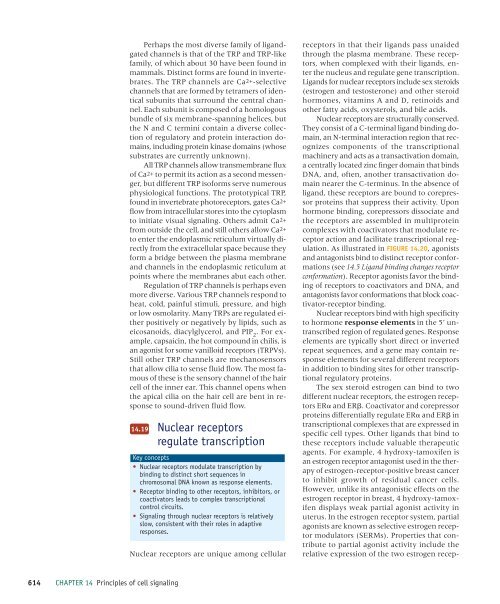Principles of cell signaling - UT Southwestern
Principles of cell signaling - UT Southwestern
Principles of cell signaling - UT Southwestern
You also want an ePaper? Increase the reach of your titles
YUMPU automatically turns print PDFs into web optimized ePapers that Google loves.
39057_ch14_<strong>cell</strong>bio.qxd 8/28/06 5:11 PM Page 614<br />
Perhaps the most diverse family <strong>of</strong> ligandgated<br />
channels is that <strong>of</strong> the TRP and TRP-like<br />
family, <strong>of</strong> which about 30 have been found in<br />
mammals. Distinct forms are found in invertebrates.<br />
The TRP channels are Ca2+-selective<br />
channels that are formed by tetramers <strong>of</strong> identical<br />
subunits that surround the central channel.<br />
Each subunit is composed <strong>of</strong> a homologous<br />
bundle <strong>of</strong> six membrane-spanning helices, but<br />
the N and C termini contain a diverse collection<br />
<strong>of</strong> regulatory and protein interaction domains,<br />
including protein kinase domains (whose<br />
substrates are currently unknown).<br />
All TRP channels allow transmembrane flux<br />
<strong>of</strong> Ca2+ to permit its action as a second messenger,<br />
but different TRP is<strong>of</strong>orms serve numerous<br />
physiological functions. The prototypical TRP,<br />
found in invertebrate photoreceptors, gates Ca2+<br />
flow from intra<strong>cell</strong>ular stores into the cytoplasm<br />
to initiate visual <strong>signaling</strong>. Others admit Ca2+<br />
from outside the <strong>cell</strong>, and still others allow Ca2+<br />
to enter the endoplasmic reticulum virtually directly<br />
from the extra<strong>cell</strong>ular space because they<br />
form a bridge between the plasma membrane<br />
and channels in the endoplasmic reticulum at<br />
points where the membranes abut each other.<br />
Regulation <strong>of</strong> TRP channels is perhaps even<br />
more diverse. Various TRP channels respond to<br />
heat, cold, painful stimuli, pressure, and high<br />
or low osmolarity. Many TRPs are regulated either<br />
positively or negatively by lipids, such as<br />
eicosanoids, diacylglycerol, and PIP 2<br />
. For example,<br />
capsaicin, the hot compound in chilis, is<br />
an agonist for some vanilloid receptors (TRPVs).<br />
Still other TRP channels are mechanosensors<br />
that allow cilia to sense fluid flow. The most famous<br />
<strong>of</strong> these is the sensory channel <strong>of</strong> the hair<br />
<strong>cell</strong> <strong>of</strong> the inner ear. This channel opens when<br />
the apical cilia on the hair <strong>cell</strong> are bent in response<br />
to sound-driven fluid flow.<br />
14.19<br />
Nuclear receptors<br />
regulate transcription<br />
Key concepts<br />
• Nuclear receptors modulate transcription by<br />
binding to distinct short sequences in<br />
chromosomal DNA known as response elements.<br />
• Receptor binding to other receptors, inhibitors, or<br />
coactivators leads to complex transcriptional<br />
control circuits.<br />
• Signaling through nuclear receptors is relatively<br />
slow, consistent with their roles in adaptive<br />
responses.<br />
Nuclear receptors are unique among <strong>cell</strong>ular<br />
receptors in that their ligands pass unaided<br />
through the plasma membrane. These receptors,<br />
when complexed with their ligands, enter<br />
the nucleus and regulate gene transcription.<br />
Ligands for nuclear receptors include sex steroids<br />
(estrogen and testosterone) and other steroid<br />
hormones, vitamins A and D, retinoids and<br />
other fatty acids, oxysterols, and bile acids.<br />
Nuclear receptors are structurally conserved.<br />
They consist <strong>of</strong> a C-terminal ligand binding domain,<br />
an N-terminal interaction region that recognizes<br />
components <strong>of</strong> the transcriptional<br />
machinery and acts as a transactivation domain,<br />
a centrally located zinc finger domain that binds<br />
DNA, and, <strong>of</strong>ten, another transactivation domain<br />
nearer the C-terminus. In the absence <strong>of</strong><br />
ligand, these receptors are bound to corepressor<br />
proteins that suppress their activity. Upon<br />
hormone binding, corepressors dissociate and<br />
the receptors are assembled in multiprotein<br />
complexes with coactivators that modulate receptor<br />
action and facilitate transcriptional regulation.<br />
As illustrated in FIGURE 14.20, agonists<br />
and antagonists bind to distinct receptor conformations<br />
(see 14.5 Ligand binding changes receptor<br />
conformation). Receptor agonists favor the binding<br />
<strong>of</strong> receptors to coactivators and DNA, and<br />
antagonists favor conformations that block coactivator-receptor<br />
binding.<br />
Nuclear receptors bind with high specificity<br />
to hormone response elements in the 5’ untranscribed<br />
region <strong>of</strong> regulated genes. Response<br />
elements are typically short direct or inverted<br />
repeat sequences, and a gene may contain response<br />
elements for several different receptors<br />
in addition to binding sites for other transcriptional<br />
regulatory proteins.<br />
The sex steroid estrogen can bind to two<br />
different nuclear receptors, the estrogen receptors<br />
ER and ER. Coactivator and corepressor<br />
proteins differentially regulate ER and ER in<br />
transcriptional complexes that are expressed in<br />
specific <strong>cell</strong> types. Other ligands that bind to<br />
these receptors include valuable therapeutic<br />
agents. For example, 4 hydroxy-tamoxifen is<br />
an estrogen receptor antagonist used in the therapy<br />
<strong>of</strong> estrogen-receptor-positive breast cancer<br />
to inhibit growth <strong>of</strong> residual cancer <strong>cell</strong>s.<br />
However, unlike its antagonistic effects on the<br />
estrogen receptor in breast, 4 hydroxy-tamoxifen<br />
displays weak partial agonist activity in<br />
uterus. In the estrogen receptor system, partial<br />
agonists are known as selective estrogen receptor<br />
modulators (SERMs). Properties that contribute<br />
to partial agonist activity include the<br />
relative expression <strong>of</strong> the two estrogen recep-<br />
614 CHAPTER 14 <strong>Principles</strong> <strong>of</strong> <strong>cell</strong> <strong>signaling</strong>
















